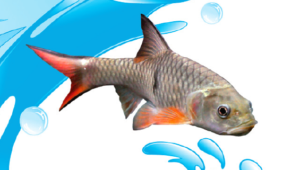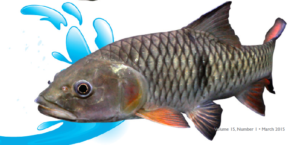Mention a Barb and most likely, people will associate it with the Tiger Barb (Puntius tetrazona). The Tiger Barb is a very beautiful fish with a light orange base body color adorned with 4 vertical black stripes and a red face, fins, and tail.
The species also comes in different variants like the Albino, Green Sumatra, and Glass. Surely most fish hobbyists have had this popular species of Barb one time or another. This 2-inch fish, after all, is probably the most popular Barb species in the world. After some time, hobbyist will try their hands with other Barb species. In the Philippines, other Barbs commonly bred locally for the aquarium trade are the Rosy Barb (Pethia conchonius), Cherry Barb (Puntius titteya), Golden Barbs (Puntius semifasciolatus), and Black Ruby Barb (Puntius nigrofasciatus), among others. However, these are relatively Tiger Barb sized.

If you are looking for bigger Barbs that grow to about 6 inches, your choices would be the Aurelius Barb (Puntius arulius), One Spot Barb (Puntius terio), Red Line TorpedoBarb (Puntius denisonii), and the T-Barb or Spanner Barb (Puntius laterstriga), which used to be easily available, but seems to be rare nowadays. The giant barb But among Filipino fish hobbyists, the giant among the barbs is the Tinfoil barb (Barbonymus schwanenfeldii). This 12-inch fish dwarfs all the Barbs we are well familiar with. That is so because we haven’t really seen the real monster Barbs.
Unknown to most fish hobbyists, there are many giant Barbs swimming in the mighty Mekong River that never made their way here to our tanks. One such species is theHampala Barb (Hampala macrolepidota). Thus, when my fish supplier said he had three 12-inch specimens. I told him to bring them right over. Actually, I am personally aware that the H. macrolepidota was imported to the country some ten years ago. In fact, I remember buying some 3-inch juveniles then, but I can’t remember enjoying them because they were small.
At three inches, they basically behaved like Aurelius Barbs and seemed to be just another member of a peaceful community aquarium. But the big boys are totally a different story. They are truly what monster fish keepers would like to see in a fish… big, fast, and voracious eaters.These three fishes can gobble up a handful of superworms before you can actually position yourself in front of the tank to watch. To enjoy them eat, you will have to ask someone to drop the superworms for you while you sit and wait.

Feeding is quite a sight, given how greedy they can be, and this fish may actually out-eat a Peacock Bass for food! The H macrolepidota is a large fish. The ones I have are not even half grown. It grows to about 70 centimeters or 28 inches, and weighs 7 to 8 kilos in the wild. It is also a shoaling fish, so it needs the company of its own kind. Their requirements Thus, if you wish to have some in your tank, make sure you have an exceptionally large tank with plenty of swimming space since they are active and fast swimmers.
Since it is a riverine fish species, the tank must have a good current and be well-aerated. A very good filtration system is necessary, with adequate flow rate a must. Provide further current by adding a powerhead near the top of the tank. The top of the tank should also be kept covered at all times as the H macrolepidota is a very good jumper.
The H macrolepidota was first described by German naturalist Heinrich Kuhl and Dutch zoologist Johan Coenraad van Hasselt in 1823. H macrolepidota is one of seven species in the genus Hampala. Incidentally one species, the H lopezi, is endemic to Langbuan, Busuanga in the Philippines. H macrolepidota is found in the Mekong and Chao Phraya basins, the Malay Peninsula, and Indonesia. It occurs mainly in clear rivers or streams with running water and sandy to muddy bottoms. It is found in most water bodies, except small creeks, torrents, and shallow swamps.
In Thailand it is known as Pla Kasoop, and in Malaysia, it is called Sebarau. In both countries, the H macrolepidota is an important food fish commonly seen in localfish markets and is said to be of good eating but bony. It is also a popular game fish; sports fishermen aspire to catch it using fly fishing gear or light tackle. Anglers believe weight for weight the H macrolepidota is the hardest fighting freshwater fish in their side of the world.

Personally, I would like to see the H macrolepidota in our aquariums because it is such a beautiful fish. It has a metallic bronze body adorned by a black bar or blot between the dorsal and pelvic fins. The dorsal fin is generally clear in color but the caudal fin or tail is a vibrant orange to red with a black longitudinal stripe at the margin of both lobes. The other fins are all orange to red in color. It has a large stocky head with the eyes located along the upper side. The mouth is big, with ‘barbels’ at the side. Its head is hard, as you can hear the ‘thud!’ when they accidentally bump the tank walls.
In the aquarium, the H macrolepidota does well in water with a pH range of 5.5 – 8.0 and hardness of 36 – 357 ppm. Being a Southeast Asian fish, it is best kept in water temperatures ranging from 20 – 28 °C. In the wild, juveniles are generally omnivorous while they become carnivorous as adults. When young, they feed on planktons and zooplanktons. They then learn to feed on small insects.
As adults, the majority of their diet consists of fish and shrimp. In captivity, feeding the H macrolepidota is an exciting activity. They are gregarious feeders and will eat anything. They hardly refuse anything thrown to them. Thus they are very easy to feed. They take processed fish food like pellets as well as fresh meats cut to size. Superworms are another favorite. They easily pick these up and swallow two or three pieces at a time. But nothing compares to feeding the H macrolepidota live feeder fish. Pandemonium ensues when feeder fish is offered. All chaos breaks loose in the tank as they race against each other trying to gobble up as many fish they can.
The H macrolepidota can be kept with other fishes so long as they are too big to be considered food. Bear in mind, however, that tankmates should also be fast and quick so that they won’t be on H macrolepidota’s menu and they won’t have to fight the bigger fish when feeding. In this age, when keeping monster fish is fashionable, I hope the H macrolepidota will be reintroduced to the Philippine aquarium trade. We tried reintroducing the H macrolepidota 10 years ago, but somehow, its popularity never took off.
Maybe this time around, the H macrolepidota can reenter the scene with a lot of noise.Maybe with the same noise you hear when it sucks down its prey at the surface of the tank! Imagine a huge tank with a large Arowana swimming gracefully about, a few large Tiger Danioides settling in their corner of the tank, and some jumbo Clown Loaches hugging the tank bottom―and a shoal of H macrolepidota swimming all over the tank. Wouldn’t that “Little Mekong” be a magnificent sight in your patio?
This appeared in Animal Scene’s March 2015 issue.






